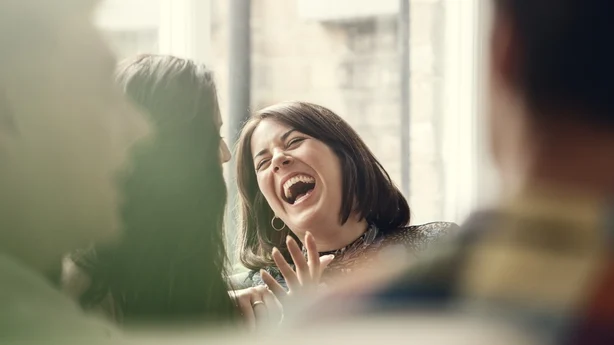Did you know that the Irish language is one of the oldest surviving languages in the world?
The oldest remains of Ancient Irish can be found on Ogham stones, dating back from the 5th and 6th centuries, while the first account of Old Irish can be found written in the Roman alphabet before the start of the 7th century,
Irish is the oldest written vernacular north of the Alps; even the Anglo Normans began speaking 'as Gaeilge' soon after they settled in Ireland. However, not long after this point, English became the language required to conduct legal and administrative affairs through.
Between 1845 - 1849, the Great Famine incited not only the death but mass emigration of many native speakers, leading to further Anglicisation that pushed the Irish language to the brink of extinction.
So, who speaks it, how it is being used today, and why is it worth brushing up on your cúpla focal?

Do we still speak Irish?
According to the 2016 Census, 1.77 million people in the Republic of Ireland can speak Irish. A compulsory subject taught in both primary and secondary schooling, as well as at a very basic level in some Montessoris or playschools (who could forget hearing 'dún an doras' or 'suigh síos?).
Today, there are many Gaelcholáistí and Gaelscoils across the country, providing the opportunity for children to experience a full education through Irish. All state exams are readily available to be taken in Irish. The Gaeltacht is a right of passage for many young Irish children and teenagers; heading to regions where Irish is still the local vernacular for a few weeks each Summer to learn, speak and cause general chaos ‘as gaeilge’.
So, yes, we do still speak it. That being said, it’s still commonplace to hear disheartening phrases like ‘dead’ and ‘useless’ being associated with our native language.
"Using Gaeilge, to me, is like breathing," says TV presenter and podcaster Síomha Ní Ruairc.
"It's my native tongue and the language we spoke at home. When I hear Gaeilge being spoken 'in the wild', it gives me such a boost - it really shouldn't take me by surprise, with over two million people on this island having some level of Irish, it's a common occurrence! But I can't help but feel an affinity to Irish speakers and the community, as they understand me and I understand them in a very genuine and natural way."
We need your consent to load this Instagram contentWe use Instagram to manage extra content that can set cookies on your device and collect data about your activity. Please review their details and accept them to load the content.Manage Preferences
Why should we speak Irish?
Many of the debates made in favour of speaking Irish point to patriotism, culture, and even as a form of passive rebellion.
In 1893, Dubhghlas de hÍde, (Douglas Hyde) Eoin Mac Néill, (Eoin Mac Neill) Father Eoghan Ó Gramhnaigh (Eugene O’Growney) and others established Conradh na Gaeilge (the Gaelic League) – this ignited a mass movement in support of maintaining and reviving the Irish language, including bringing the grammar of the older written language in line with the more modern spoken variation.
"Being Irish is like a tapestry and the tapestry has our history, culture and language all woven together, explains Yvonne O'Toole, Principal of The Institute of Education.
"Our language is a beautiful language that we should be proud to speak and encourage others to speak. Our language is what identifies us from other cultures and nationalities, and any effort to speak Irish should be encouraged."
"There is something about some phrases in Irish that are so much better than their English counterparts in terms of how they sound and what they literally mean," adds Megan Kyne, Megan Kyne, Primary School Teacher and Event Manager based in Toronto, Canada.
"There is also the great perk that when you’re speaking it there are very few people outside of Ireland who can understand what you are saying! I don’t know if I can fully articulate just how much I appreciate having Irish, the pride I feel in the language and it being our own. Is fearr gaeilge briste ná béarla cliste!"
We need your consent to load this Instagram contentWe use Instagram to manage extra content that can set cookies on your device and collect data about your activity. Please review their details and accept them to load the content.Manage Preferences
Where can we see Irish being used today?
Today, we can see Irish being used increasingly across entertainment, arts, and culture as well as in daily life.
In film, recent examples include Colm Bairéad’s An Cailín Ciúin, a movie that received 11 nominations at the 18th IFTAs and became the first Irish-language film to be shortlisted for an Oscar in the Best International Feature Film category.
In song, there are, of course, an infinite number of folk and trad songs that come to mind, but some more recent and pop culture-prevalent include Hozier’s Uiscefhuaraithe, a song inspired by the untranslatable meaning of its title: ‘something that has been made cold by water’.
The Coronas' Taibhsí nó Laochra (a translation of their song Heroes or Ghosts) is written entirely in Irish, as are many of the recent hits from Belfast hip-hop trio Kneecap.

Even the world of fashion has been infiltrated by Irish, from designers like Róisín Pierce naming her meaningful, heritage-inspired collections Mná ì Bláth and Bláthanna Fiáin, to the recently appointed Creative Director of Alexander McQueen, Seán McGirr, including Irish translations in the introduction for the livestream of his debut runway collection under the label.
"Beatha teanga í a labhairt' as the proverb tells us: a living language will survive," says Liam Dingle, Deputy Principal of The Institute of Education.
"If Irish is not spoken as part of the fabric of Irish culture in what is an increasingly diverse and always evolving entity, it will be lost, along with all the components of its cultural hinterland. This, to me, would be a transgression future generations would not thank us for."
We need your consent to load this Instagram contentWe use Instagram to manage extra content that can set cookies on your device and collect data about your activity. Please review their details and accept them to load the content.Manage Preferences
How does the use of Irish make us feel, and why?
As Pádraig Pearse once said: "Tír gan teanga, tír gan anam" – a country without a language, is a country without a soul.
There is a reason so many feel deeply connected to the Irish language, and there are also reasons some do not .
Most conversations on the subject point to the ways in which Irish is taught in schools and it’s usability in daily life. However, our country’s history of empirical rule, oppression, and forced emigration is something grounded in facts, records and testaments.
If Ireland continued to grow and prosper independently, we might speak Irish as fluently and fluidly as other countries speak their own. For this reason, using Irish in daily life – whether it’s changing your smartphones language or seeing a ‘cúpla focal’ as you scroll – can feel empowering.
As Ella Ní Hanrachtaigh, a Social Worker based in the UK, says: "It makes me feel extremely proud, passionate and emotional as I really admire people who make even the smallest bit of effort to keep our native language alive."
Niamh Burns, Intern at the France Ireland Chamber of Commerce based in Paris, France, adds: "I've gotten super back into using my Irish le deanai and it makes me feel so much more connected to my identity when I’m abroad. It also helps me think more about my personal identity and how that is connected more deeply to something beyond me…but that’s a whole other kettle of fish!"

Where to start?
As an expatriate, Irish has come in useful more times than I can count when nattering away on the tube, subway or tuk tuk – often helping me and my friends navigate tricky, slightly precarious situations we wouldn’t have been able to have without such a nifty secret weapon in our arsenal.
Moreover, the innate pride that comes with speaking your own language (no matter the level of fluency or accuracy) is unmatched – especially given the strife and struggle our language has succeeded in spite of.
The continuous modernisations and adaptations of the language being made, allowed or encouraged thanks to the work of organisations like Conradh na Gaeilge also mean that any arguments regarding usability have, in my opinion, more or less been rendered redundant.
How I see it, Bearlacus is, in theory, as adaptable to daily life in Ireland as Frenglish or Franglais is in certain parts of Canada.
We need your consent to load this Instagram contentWe use Instagram to manage extra content that can set cookies on your device and collect data about your activity. Please review their details and accept them to load the content.Manage Preferences
A starting point could be to follow some key Gaeilgeoir accounts, regardless of your level: @muinteoirmeg, @thegaeilgegal, @siomhaniruairc, @gaeilge_bheo and @cuplafocal_
There are also fun Irish language podcasts you can stick on while doing the washing like Beo Ar Éigean, 30 SOS, CRAIC POD, Gaeilge Anois, agus How to Gael.
Essentially, if you’re willing and capable of learning Irish, it’s ready to be spoken or consumed in any way that makes sense to you.
So, the real question is, why not give it a go?
Disclaimer: The copyright of this article belongs to the original author. Reposting this article is solely for the purpose of information dissemination and does not constitute any investment advice. If there is any infringement, please contact us immediately. We will make corrections or deletions as necessary. Thank you.






